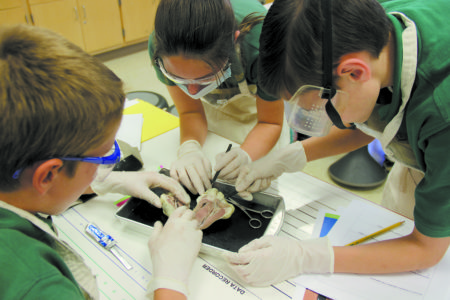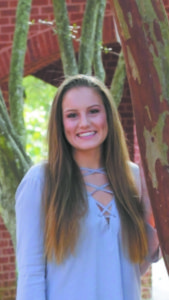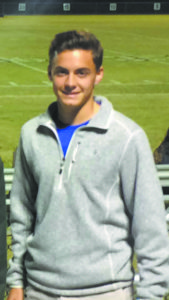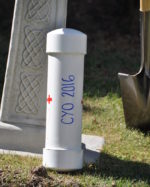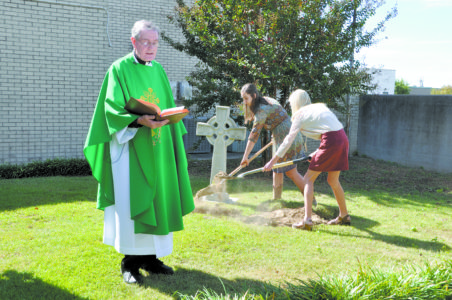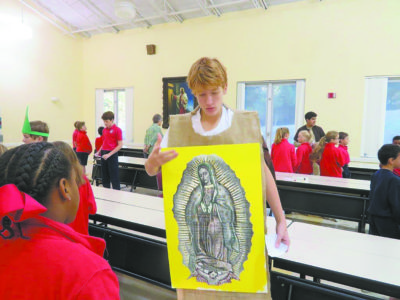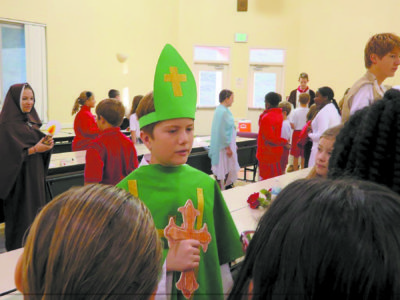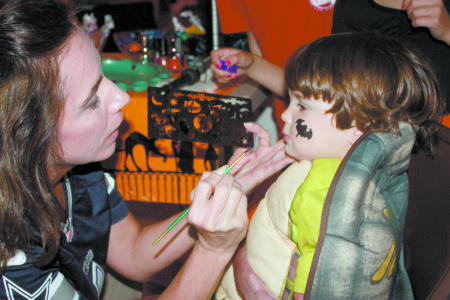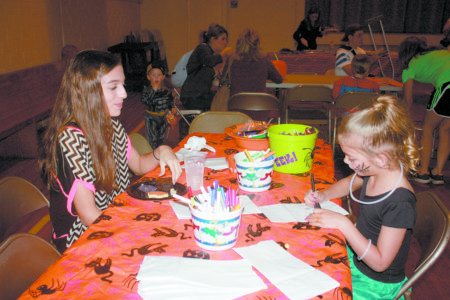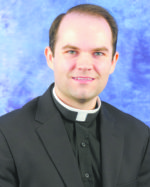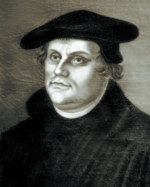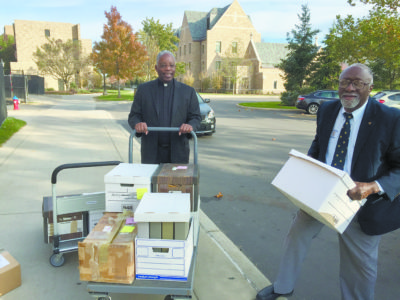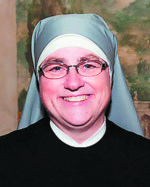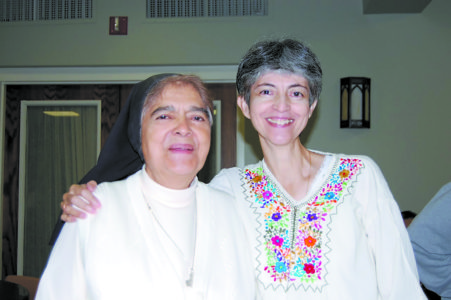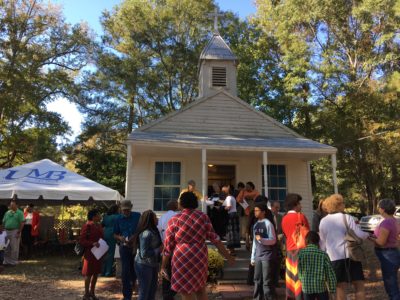
Cranfield St. John the Baptist mission is a country church, often the Sunday home to Louisiana Catholics who are visiting nearby hunting camps.
By Mary Woodward
CRANFIELD – On Sunday, Nov. 6, a beautiful, fresh autumn day, more than 100 people gathered with Bishop Joseph Kopacz to mark the centennial of St. John the Baptist Mission at an early afternoon Mass. The wood-framed church holds roughly 50 people. The overflow congregation was sheltered in a tent outside under the trees.
Shortly before the Mass was scheduled to begin at 1 p.m., a communicant arrived on a four-wheeler, reflecting the mission’s proximity to nearby hunting camps where many Louisiana Catholics come during hunting season. She zipped in and parked opposite the tents and took her place among the congregation.
The windows of the church were wide open and the breeze of the day kept the natural flow of creation present as those gathered entered into the Divine Liturgy. The setting of the day brought us back to 100 years ago when Bishop John Gunn, SM, preached an eloquent sermon on the parable of the Good Samaritan likening the Cranfield mission to the protagonist who cared for the one in need.
The history of the mission is a prime example of a dedicated shepherd who traversed fields and valleys, climbed hills and braved thickets to find his flock. In his time Father Matthew Morrissey, SSJ, became known as the “Father of Missions” in the southwest corner of the diocese.
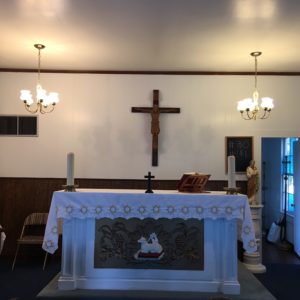
The inside view of the church.
The Natchez ministry of Father Morrissey began in 1901 when he arrived at Holy Family Church. The parish was established in 1890 to serve African American Catholics in the Natchez area. Having been invited by Bishop Thomas Heslin, the Josephites have staffed Holy Family since 1895.
Under Father Morrissey, Holy Family soon became the mother church of four missions – Cranfield, Harriston, Laurel Park and Springfield. On Monday mornings after his weekend duties at Holy Family, Father Morrissey would head out into the county in search of any Catholics and also those who were not church-going. During his circuit he often came upon Catholics who were not able to get into Natchez very often to receive the sacraments. This is where the story of Cranfield has its roots.
According to a history of the Cranfield mission written in 1945 by Father Arthur Flanagan, SSJ, pastor of Holy Family at the time, Soon after his arrival in Natchez, Father Morrissey came upon the Irish Catholic family of John Gordon Fleming living on the outskirts of Cranfield. Fleming told Father Morrissey the family originally came from County Mayo, Ireland in the late 1870s. Fleming’s relative, Holliday Fleming, was the oldest son of the immigrants and brought with him his wife and children. The family would go to Mass in Natchez at St. Mary on Easter and Christmas – weather permitting. The children were all baptized and received sacraments from St. Mary.
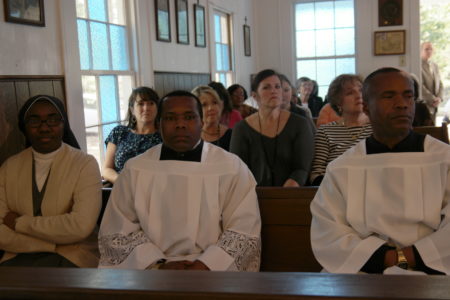
Before the anniversary Mass, Father George Ajuruchi, SSJ, was installed as pastor at Natchez Holy Family and Fayette St. Anne. Some of his friends and family, pictured above, from his home country of Nigeria came for the day of celebrations. (Photo by Valencia Hall)
The next half of the story told by Fleming holds a true Mississippi cultural twist and a wonderful image of the people of God. Fleming explained to Father Morrissey that Holliday Fleming had been “true to his name, [and] went holidaying with the result that he was blessed” with a growing African-American family. Father Morrissey made sure these children were brought to Holy Family for sacraments and given their father’s name.
Soon after meeting the Flemings, Father Morrissey laid plans to build a church in Cranfield. After a few years of saving pennies and nickels from various appeals, there finally were enough funds to build the church on the land donated by Mrs. Boggart, a local Catholic. The mission priest, along with the older African-American Fleming children, built the church themselves. As great artists often sign their masterpieces, Linda Floyd, a descendant of the original Fleming family, relayed that the young men who worked on the church inscribed their names in the steeple.
Initially religious education, taught by Rosie Washington, was held in the church as there was no other building on the site. In 1938, a bus from Natchez came to bring the children to St. Francis School at Holy Family. On the weekend when Mass was not celebrated in the mission the bus often was used to bring people from the missions to Mass at Holy Family.
As the years passed, the other three missions closed. Today Cranfield is the last of the four built by Father Morrissey. His missionary zeal reflects the true spirit of our diocese as a rural mission territory. For Bishop Kopacz – 100 years later – the day began in Natchez with the installation of Father George Ajuruchi, SSJ, as new pastor of Holy Family; then we traveled to Fayette St. Anne for Father Ajuruchi’s installation there as pastor.
From Fayette we headed to Cranfield. The road soon became narrower and less paved and we witnessed the terrain of Father Morrissey. Driving from Holy Family to Fayette and then down to Cranfield gave us a great lesson in history and an even greater perspective on mission life in the church.
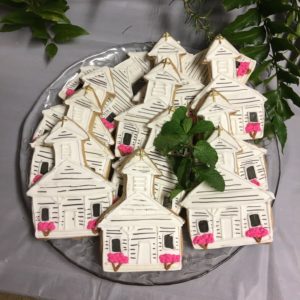
A sweet personal touch to the celebration — cookies made in the image of the church.
It was 100 years ago on Sept. 3, 1916, when Bishop John Gunn, SM, dedicated the mission church built by Father Matthew Morrissey, SSJ, and his flock. Since then many striking autumn days have filled the hearts and minds of the people of this unique mission. For those who live in larger parishes, a trip to Cranfield St. John the Baptist would be good for the Catholic soul.
(Mary Woodward is the diocesan chancellor.)

